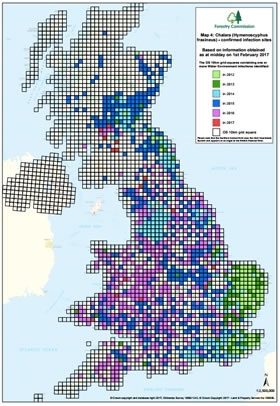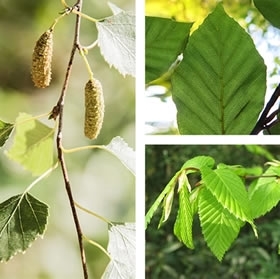 By Dr Matt Elliot, Conservation Advisor, Woodland Trust
By Dr Matt Elliot, Conservation Advisor, Woodland Trust
Ash dieback, caused by the fungus Hymenoscyphus fraxineus, was first discovered in the UK in 2012. Since this initial finding in the south east of England, the disease caused by this fungus has been found throughout the UK.
Initially it was believed that the fungal spores blew into the south east of England from the continent, however, whilst this is possible, it has since become clear that the disease was imported on infected planting stock and moved throughout the country within the nursery trade. The disease then moved from infected planted sites onto ash trees in the wider environment.
In order to map the spread and provide disease progression information the Forestry Commission has produced a map which is regularly updated. This map divides the country into 10km grid squares; once a positive finding has been made within a grid square the area is classed as positive. As of 4th January 2017, 40.6% of UK grid squares are positive for ash dieback. The map can be viewed here.
The disease has a cyclical nature with trees being re-infected year on year as spores from the infected leaf litter re-enter the leaves of surrounding ash trees. As a result young trees become infected and die very quickly but larger trees can take a number of years to completely die, although sign of crown dieback will be seen as the tree declines.
A number of scientific research projects have been initiated since 2012, largely funded by DEFRA. Initial findings suggest that some ash populations in the UK might have an inherent tolerance to ash dieback which gives hope that not all ash trees will be lost and that the population could recover given time (>50 years). This is contrary to the experience on the continent where a large proportion of ash has been lost since ash dieback was first discovered in Poland in 1992. Denmark for example has lost 95% of its ash trees.
Research has also shown that the spores are short lived and that a high number of spores are required for infection. It is also unlikely that spores can be transported on clothing, animals or birds. The highest risk of movement, apart from moving infected trees, is by the inadvertent movement of leaf litter on machinery wheels or footwear. Advice on good biosecurity practices can be found on the Observatree website here.
 The Woodland Trust is involved in shaping the next steps for ash dieback research both at DEFRA and by funding research ourselves. We are concerned about the potential loss of ash from hedgerows as well as from roadsides and along rail lines, not just from disease but because of the lack of planting due to fears over tree safety. The loss of non-woodland ash will have a devastating impact on our landscape due to the loss of habitat and wildlife corridors. We are therefore urging for more applied research that leads to a greater understanding of how to manage ash dieback.
The Woodland Trust is involved in shaping the next steps for ash dieback research both at DEFRA and by funding research ourselves. We are concerned about the potential loss of ash from hedgerows as well as from roadsides and along rail lines, not just from disease but because of the lack of planting due to fears over tree safety. The loss of non-woodland ash will have a devastating impact on our landscape due to the loss of habitat and wildlife corridors. We are therefore urging for more applied research that leads to a greater understanding of how to manage ash dieback.
It is important that we continue to plant a wide range of tree species in order that we can provide important habitats whilst giving our woods resilience against future pests, pathogens and climate change. As a result the Woodland Trust have produced ‘Targeting Tree Disease Packs’ which can be purchased online here.
Get the Latest News & Advice
Join over 100,000 subscribers and stay updated on our latest advice, research, news and offers.
*You may change your mind any time. For more information, see our Privacy Policy.